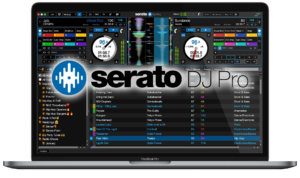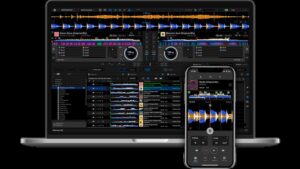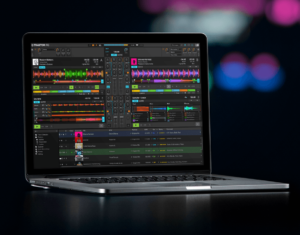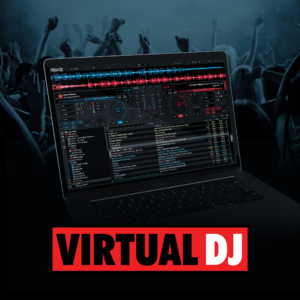
As a DJ, unless you DJ with records or CDs exclusively (which very few people do nowadays), you are going to need to choose a DJ software platform. This is one of the biggest decisions you’ll make in your DJing, akin to a music producer deciding if they want to use Ableton Live, Logic Pro or FL Studio to make music with.
And just like in music production, there are many pieces of software to choose from, not just those three I mentioned (there’s also Cubase, Bitwig Studio, Reaper…) – the same is true for DJ software.
So what is the best DJ software 2023? The two most used platforms among the Digital DJ Tips community are easily Rekordbox and Serato, but other names include Traktor, Virtual DJ, djay Pro, and Engine DJ, all of which we’ll cover here. There are others too, though.
What software you choose is important. It often defines what DJ hardware you can use, and at the very least how easily you can use that hardware. Also, switching software is painful, as DJs necessarily get deeply attached to workflows that are tied to the software they’ve chosen.
And yet many DJs seem to end up on one platform or another by accident. Usually when you buy a piece of DJ gear you like the look of, you realise it has a software platform it’s designed to work with, and that’s that – that’s your platform!
But it may not be the right one for you. And as I say, once you’ve chosen, it’s hard to change. So in this roundup, we’ll look at all the big platforms, and I’ll explain to you what they do and don’t do, what hardware they work with, and the types of DJs that use them.
If you’re brand new to DJing and haven’t chosen yet, then this a great time to read this. And if you think you’ve ended up DJing on the wrong platform for you, this guide will hopefully either put your mind at rest that actually all is fine, or finally convince you to make the leap to where you think you should be.
We’ll start by talking about what DJ software actually does, then we’ll look at the six platforms I mentioned in the intro, one by one. By the end you’ll have a good idea of what’s out there, and the choices you have.
DJ software has two distinct jobs: The first is a library preparation tool, and the second is a performance tool. Let’s look at those two jobs separately.
The music files on your computer aren’t ready for DJing as they stand. Nowadays, DJs “analyse” their music before a performance to add vital info, and importantly, organise it into playlists to make DJing easier.
Things like graphical waveforms (so the DJ can see where different parts of the track fall, like breakdowns and drops), key analysis (for harmonic mixing), “beatgrids” (info about the BPM/tempo and where the beats in the track fall), and user-added cue points and loops (for live remixing and quick mixing) can all advantageously be added to tracks before a gig, and the DJ software is where you do that.\
As I mentioned, sorting your music out into playlists is also a good idea, as is tidying up its “metadata” (artwork, artist, title and so on) – and the best place to do this is also in your DJ software. All of the software in our guide here allows you to do everything I just mentioned.
So it’s time to DJ! For many DJs, this means plugging a DJ controller or other DJ gear into their laptop, where their DJ software is now used as a performance tool.
Effectively, the laptop is the “brains” of the DJ set-up. It is where music is loaded, manipulated and mixed. The DJ equipment is really just a glorified input device. Your keyboard and trackpad are other examples of input devices, and indeed most DJ software can be controlled via those too.
Think of DJ equipment as essentially a more DJ-friendly form of input device, where instead of typewriter keys and mouse controls, you get faders, jogwheels and performance pads.
(The equipment does do other things, like visual feedback from the computer, and audio tasks, but for the purposes of this lesson, this description works fine.)
Your DJ software shows you virtual “decks”, waveforms, where you are in the tracks you’re playing, and gives you access to your library of music so you can load tracks. It will link to your music streaming services if you use them, and also give you audio level info. In other words, it is a digital version of all the stuff that is done on hardware with non-computer DJ set-ups.
However, not all DJs use a laptop in the DJ booth. Two of the platforms we cover here (Rekordbox and Engine DJ) are used by these DJs. Once you’ve prepared your music to DJ with, with these platforms, you can also “export” a playlist or playlists to a USB drive or SD card. (Rekordbox is actually both a performance platform and a library prep tool, as we’ll see.)
The idea is that you plug this USB or SD card into the DJ gear, and all that track analysis is then available to the DJ gear without your laptop being present. You get many of the advantages of using DJ software, but on “standalone” DJ gear.
So you see that you already have one big decision to make: Will you be a “laptop DJ”, or a “standalone gear” DJ? Because if you want to be the latter, your choice is already down to two platforms! (And if you think you may want to do both, Rekordbox is probably – all else being equal – going to be the platform for you.)
OK, so now we know why we need software and what it does, let’s look at the platforms one-by-one.

Serato is pretty much neck-and-neck with Rekordbox (see below) as far as popularity goes, but is a slightly different proposition. Serato gained popularity particularly in the USA, and particularly among hip-hop and scratch DJs – indeed, it used to be called “Serato Scratch Live”. And it is designed exclusively to be used by laptop DJs – you can’t export Serato-analysed music to a USB drive and use it on hardware away from your laptop.
As Serato doesn’t make its own hardware (in common with most of the platforms here), it licences third-party hardware instead, so there’s lots of choice. You can use it with hardware from names like Rane, Numark, Roland, Denon DJ, Reloop and indeed Pioneer DJ, including its pro DJ gear of the type you find in clubs. Serato tends to keep tight control over these integrations, meaning they are usually water-tight, reliable and easy to use.
✅ Reasonably well-featured, with music streaming integration, video playback and all modern performance features
✅ A good “all round” choice, equally at home with electronic music and other styles
✅ Arguably the best implementation of real-time stems DJing of any platform
❌ Comes in two versions, Serato DJ Lite and Serato DJ Pro, and if your gear comes with the former, you need to pay to update to the latter
❌ Many of the advanced features require you to buy them as extra “Expansion Packs”; expensive overall
Typically used by: All types of laptop DJ, from open format to mobile, scratch DJs to electronic
Works on: Windows, Mac

Pioneer DJ is the biggest name in DJing, and Rekordbox is its platform. Whether you buy a “lowly” Pioneer DJ controller such as the DDJ-400, or go all-out and buy a club-standard mixer and media players (which will cost you the price of a small car), Rekordbox will be the software you use.
As a music preparation tool, it is unrivalled. That’s not least because it started life as a music preparation tool, for DJs to prepare their music before playing it on Pioneer DJ club gear (CDJ players, basically). But in recent years, it has also become a performance platform the company calls Rekordbox DJ, which is also rolled into the same piece of software.
✅ The “club standard” DJ platform, that you can use from starting your hobby all the way to being a pro club DJ
✅ Modern and powerful, with streaming services built in, video playback, lighting control and cloud library features
❌ Advanced features require you to pay a subscription
❌ No real-time stems function
Typically used by: Pro club DJs and aspiring club DJs, fans of Pioneer DJ and its ecosystem
Works on: Windows, Mac, has iOS and Android helper apps

Traktor was a leader in years gone by and remains a popular platform, although in numbers it is nowadays eclipsed by Serato and Rekordbox. It is laptop software, with no USB/standalone option, and like Rekordbox, it has a range of hardware it is designed to work best with, such as the Traktor Kontrol S4 Mk3 controller and the Traktor Kontrol Z2 mixer. Like Serato DJ, it also works fine with Pioneer DJ Pro gear such as the CDJ-3000 players.
Traktor has fallen behind feature-wise in recent years, but is catching up, with streaming services now available in the software, for instance, and a roadmap announced that included real-time stems. However, if you want to DJ with video, it’s a no-go: This is a strictly audio-only platform. (Note that there are two “Traktors” – this article is talking about Traktor Pro. The other one, “Traktor DJ”, confusingly exists concurrently.)
✅ Excellent for electronic music lovers – has industry-leading looping and effects, and great sound quality
✅ A good choice if you’re a DJ/producer who also uses Native Instruments production gear
❌ Some baffling limitations, including no flexible beatgridding, which means it is not a good choice for non-electronic music
❌ Can be hard to use, as it has lots of complex settings often with difficult workflows
Typically used by: Electronic DJs who often have been using it for a long time, and who couldn’t imagine using anything else because they’ve fallen in love with the things it undeniably does really well
Works on: Windows, Mac

Historically one of the most popular DJ platforms, and still used by a large number of DJs worldwide, with millions of downloads of its free version, and lifetime updates for those who buy it outright. Virtual DJ is the most powerful software of all on this list, and historically a platform that gets juicy new features at the cutting edge of DJing, first.
It is laptop-only software, with no standalone DJing option. Virtual DJ doesn’t make its own hardware, but it works with pretty much every piece of hardware you can get your hands on – just plug it in and chances are it’ll work fine. Maybe due to its renegade image it’s often got a bad rap in the DJ community, but that is undeserved – this is a bona fide player.
✅ Powerful, advanced platform with lots of exciting features, including real-time stems separation, video, music streaming services etc
✅ Buy it once, it’s yours forever, including all future updates – we’ve not paid a penny extra for our copy since we bought it in 2004!
❌ Not as slick as some, and you may have to work with it to get some features behaving how you wish them too
❌ Supplied effects are not as good as other platforms
Typically used by: Mobile, party and karaoke DJs, video DJs – conspicuously not embraced by house/electronic DJs, for some reason
Works on: Windows, Mac

So now you know all about the different types of DJ software, and why choosing correctly is so important. Hopefully this article has helped you to choose the right platform for you, or to decide whether or not you should switch to another. A few closing thoughts:
Good luck choosing your software, and do share your experiences and ask any questions via instagram @karanjcliff
DJ Karan Dubai